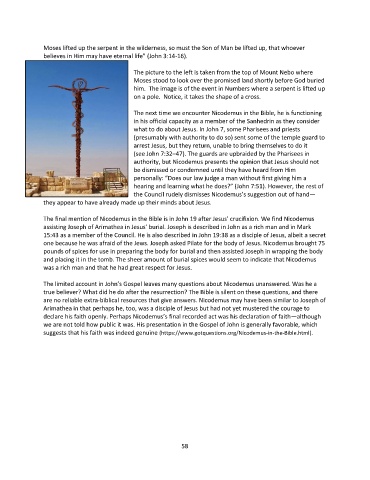Page 59 - Advanced Life of Christ - Student Textbook
P. 59
Moses lifted up the serpent in the wilderness, so must the Son of Man be lifted up, that whoever
believes in Him may have eternal life” (John 3:14-16).
The picture to the left is taken from the top of Mount Nebo where
Moses stood to look over the promised land shortly before God buried
him. The image is of the event in Numbers where a serpent is lifted up
on a pole. Notice, it takes the shape of a cross.
The next time we encounter Nicodemus in the Bible, he is functioning
in his official capacity as a member of the Sanhedrin as they consider
what to do about Jesus. In John 7, some Pharisees and priests
(presumably with authority to do so) sent some of the temple guard to
arrest Jesus, but they return, unable to bring themselves to do it
(see John 7:32–47). The guards are upbraided by the Pharisees in
authority, but Nicodemus presents the opinion that Jesus should not
be dismissed or condemned until they have heard from Him
personally: “Does our law judge a man without first giving him a
hearing and learning what he does?” (John 7:51). However, the rest of
the Council rudely dismisses Nicodemus’s suggestion out of hand—
they appear to have already made up their minds about Jesus.
The final mention of Nicodemus in the Bible is in John 19 after Jesus’ crucifixion. We find Nicodemus
assisting Joseph of Arimathea in Jesus’ burial. Joseph is described in John as a rich man and in Mark
15:43 as a member of the Council. He is also described in John 19:38 as a disciple of Jesus, albeit a secret
one because he was afraid of the Jews. Joseph asked Pilate for the body of Jesus. Nicodemus brought 75
pounds of spices for use in preparing the body for burial and then assisted Joseph in wrapping the body
and placing it in the tomb. The sheer amount of burial spices would seem to indicate that Nicodemus
was a rich man and that he had great respect for Jesus.
The limited account in John’s Gospel leaves many questions about Nicodemus unanswered. Was he a
true believer? What did he do after the resurrection? The Bible is silent on these questions, and there
are no reliable extra-biblical resources that give answers. Nicodemus may have been similar to Joseph of
Arimathea in that perhaps he, too, was a disciple of Jesus but had not yet mustered the courage to
declare his faith openly. Perhaps Nicodemus’s final recorded act was his declaration of faith—although
we are not told how public it was. His presentation in the Gospel of John is generally favorable, which
suggests that his faith was indeed genuine (https://www.gotquestions.org/Nicodemus-in-the-Bible.html).
58

